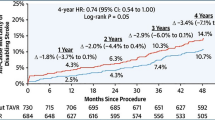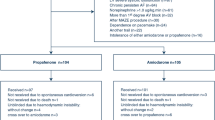Abstract
Aim
The adjunctive medication with amiodarone plays a major role in patients with an implantable cardioverter defibrillator (ICD). Amiodarone as class III antiarrhythmic drug may significantly alter the defibrillation threshold (DFT). Conflicting results exist on the clinical relevance of a DFT rise on amiodarone. The only prospective study on this issue included only a small number of patients on amiodarone. The purpose of this study was to assess the safety and clinical relevance of repeat defibrillator testing after initiation of amiodarone in modern defibrillator systems.
Methods and results
We assessed risks and clinical consequences of retesting defibrillation safety margin after initiation of amiodarone in 130 consecutive patients. All patients underwent intraoperative testing at the time of first ICD implantation. A repeated VF induction and defibrillator test (by protocol with a single shock and 10 J safety margin) after a total dose of at least 10 g amiodarone 4–6 weeks after initiation of medication was performed. DFT testing after initiation of amiodarone was safe as there were no complications that led to a prolonged hospital stay. In 4 of 114 patients with a left-sided device (1.6%) and 3 of 7 patients with a right-sided device (42.8%), a 10 J safety margin could not be achieved. As a result 4 patients (3.1% of study collective) had a revision of the system.
Conclusion
Repeat defibrillation testing after administration of amiodarone therapy rarely fails in patients with left-sided devices. We observed a higher test failure in patients with a device in the right-subpectoral position although this subgroup was small. Repeat defibrillator testing is safe as no relevant complications were observed.

Similar content being viewed by others
References
Gold MR, Higgins S, Klein R, Gilliam R, Kopelman H, Hessen S, Payne J, Strickberger SA, Breiter D, Hahn S et al (2002) Efficacy and temporal stability of reduced safety margins for ventricular defibrillation. Circulation 105:2043–2048
Morgan JM, Marinskis G, On behalf of the EHRA Scientific Initiatives Committee (2011) Defibrillation testing at the time of implantable cardioverter defibrillator implantation: results of the European Heart Rhythm Association survey. Europace 13(4):581–582
Viskin S, Rosso R (2008) The top 10 reasons to avoid defibrillation threshold testing during ICD implantation. Heart Rhythm 5:391–393
Russo AM, Sauer W, Gerstenfeld EP, Hsia HH, Lin D, Cooper JM, Dixit S, Verdino RJ, Nayak HM, Callans DJ, Patel V, Marchlinski FE (2005) Defibrillation threshold testing: is it really necessary at the time of implantable cardioverter-defibrillator insertion? Heart Rhythm 2:456–461
Blatt JA, Poole JE, Johnson GW, Callans DJ, Raitt MH, Reddy RK, Marchlinski FE, Yee R, Guarnieri T, Talajic M, Wilber DJ, Anderson J, Chung K, Wong WS, Mark DB, Lee KL, Bardy GH; SCD-HeFT Investigators (2008) No benefit from defibrillation threshold testing in the SCD-HeFT (Sudden Cardiac Death in Heart Failure Trial). J Am Coll Cardiol 52(7):551–556
Birnie D, Tung S, Simpson C, Crystal E, Exner D, Ayala Paredes FA, Krahn A, Parkash R, Khaykin Y, Philippon F, Guerra P, Kimber S, Cameron D, Healey JS (2008) Complications with defibrillation threshold testing: the Canadian experience. Heart Rhythm 5:387–390
Val-Mejias JE, Oza A (2010) Does defibrillation threshold increase as left ventricular ejection fraction decreases? Europace 12:385–388
Hodgson DM, Olsovsky MR, Shorofsky SR, Daly B, Gold MR (2002) Clinical predictors of defibrillation thresholds with an active pectoral pulse generator lead system. PACE 25:408–413
Dopp AL, Miller JM, Tisdale JE (2008) Effect of drugs on defibrillation capacity. Drugs 68:607–630
Daoud EG, Man KC, Horwood L, Morady F, Strickberger SA (1997) Relation between amiodarone and desethylamiodarone plasma concentrations and ventricular defibrillation energy requirements. Am J Cardiol 79:97–100
Neuzner J, Bahawar H, Berkowitsch A, Michel U, Schlepper M, Pitschner HF (1997) Clinical predictors of defibrillation energy requirements. Am J Cardiol 79:205–206
Hohnloser SH, Dorian P, Roberts R, Gent M, Israel CW, Fain E, Champagne J, Connolly SJ (2006) Effect of amiodarone and sotalol on ventricular defibrillation threshold. Circulation 114:104–109
Schwaiblmair M, Berghaus T, Haeckel T, Wagner T, von Scheidt W (2010) Amiodarone-induced pulmonary toxicity: an under-recognized and severe adverse effect? Clin Res Cardiol 11:693–700
Pelosi F, Oral H, Kim MH, Sticherling C, Horwood L, Knight BP, Michaud GF, Morady F, Strickberger SA (2000) Effect of chronic amiodarone therapy on defibrillation energy requirements in humans. J Cardiovasc Electrophysiol 11:736–740
Nielsen TD, Hamdan MH, Kowal RC, Barbera SJ, Page RL, Joglar JA (2001) Effect of acute amiodarone loading on energy requirements for biphasic ventricular defibrillation. Am J Cardiol 88:446–448
Kühlkamp V, Mewis C, Suchalla R, Mermi J, Dörnberger V, Seipel L (1999) Effect of amiodarone and sotalol on the defibrillation threshold in comparison to patients without antiarrhythmic drug treatment. Int J Cardiol 69:271–279
Tokano T, Pelose F, Fleming M, Horwood L, Souza JJ, Zivin A, Knight B, Goyal R, Man C, Morady F, Strickberger A (1998) Long-term evaluation of the ventricular defibrillation energy requirement. J Cardiovasc Electrophysiol 9:916–920
Roberts PR, Allen S, Betts T, Morgan JM, Urban JF, Whitman T, Euler DE, Kallok MJ (2000) Increased defibrillation threshold with right-sided active pectoral can. J Interv Card Electrophysiol 4:245–249
Acknowledgments
G. Breithardt: Research grants for his institution from 3M, Sanofi-Aventis, St. Jude, occasional honoraria for invited lectures and advisory boards of Sanofi-Aventis, Boehringer Ingelheim, Boston Scientific, Bayer Health Care.
Author information
Authors and Affiliations
Corresponding author
Additional information
J. Köbe, F. Reinke, D. Dechering and L. Eckardt: Occasional honoraria for invited lectures.
Rights and permissions
About this article
Cite this article
Köbe, J., Reinke, F., Dechering, D.G. et al. Evaluation of defibrillation safety margin in modern implantable cardioverter defibrillators after administration of amiodarone. Clin Res Cardiol 101, 185–190 (2012). https://doi.org/10.1007/s00392-011-0379-z
Received:
Accepted:
Published:
Issue Date:
DOI: https://doi.org/10.1007/s00392-011-0379-z




